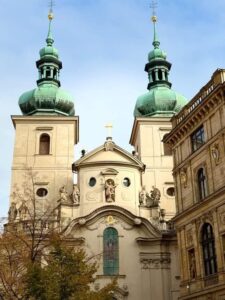All Souls´ Day | by Sasha
In Czech, November is translated as “Listopad”. Slavic language speakers will recognize “list” in this word as leaf/leaves and “pad” as a verb, akin to falling. It’s a shame they missed an opportunity to call the entire season “listopad”, would have been more fitting than one month, but I digress. It’s actually my favorite season – the view transforming into an orange, yellow and light green gradient; the comfortably chill breeze in the mornings and in the evenings, that allows me to wear my favorite outfits without overheating in them; large orange pumpkins appearing in the countryside or in supermarkets; pumpkin spice lattes – which I still have not tried when writing this, so I should get around to doing that. And finally, this list would be incomplete without mentioning the holiday of this season – Halloween. Really, autumn (or fall for American-English speakers) has it all in my opinion. It’s my favorite season before winter. I am very much biased due to my fascination with horror movies and endless love for the aesthetic of the macabre and gothic. You can easily guess why I love Prague during fall (or autumn for the British-English speakers) so much. Anyway, ahoj! I’m Aleksandre but for those of you who read these blogs should know me as Sasha. In this blog I’ll be going over Halloween, but you read the title, this is about something else, but it’s connected to this spooky holiday so I need to preface. I personally learnt a lot researching for this, so I invite you to sit this through with me as I slowly reveal the true topic of this blog:
We all know what Halloween is. You might not celebrate All Hollow’s Eve, you may love and partake in it, you may consider it pagan or demonic, but whatever it is that you feel about this celebration – you definitely know what it is. See, what you might not know is that this name “All Hollow’s Eve” makes this seemingly secular celebration a part of a bigger holiday observed by western Christians (Roman, Latin Catholicism, etc.). You heard that right folks! Halloween actually has roots in Catholicism, so associations with satanic rituals is mostly based on a perpetuating myth. “Hallow” actually means to make something holy. What we call “Halloween” is a beginning of the feast of All Hollow’s Day that starts on the eve of 31st October. This holiday and its history deserve its own piece, but for now all we should know is that this is the start of Allhallowtide – the three days when (usually) Catholics commemorate the dearly departed. “The Days of the Dead” consist of All Hallow’s Eve, All Saints’ Day and All Souls Day.

I actually didn’t know about this triduum of feasts, I only was familiar with “Día de Muertos”, which is a primarily Mexican celebration of the Day of the Dead. While it’s celebrated at the same time as Allhallowtide, it’s not really the same. The celebration is more festive and is mostly observed in Mexico or in locations with large Mexican population. Some even argue that this festivity is influenced from Indigenous Mexican culture, rather than Catholic roots. Going back to the Allhallowtide, I’d like to put a small disclaimer that the traditions, that I’ll be discussing from this point onward, practiced during these holidays will be taken from Western Catholic sources. Some communities may celebrate it differently, even some Western Catholic churches may have different traditions, but I just want to state, that I’m not covering some “one correct” practice, there is obviously no such thing. So, kicking off with the first day of this 3-day celebration, All Hallow’s Eve is an evening feast where people gathered for vigils. More popular practice nowadays involves dressing up as ghostbusters, witches or ghosts, then going out for trick or treating, or attending the local Halloween themed party. But in the context of what I was describing: a vigil is a period of purposeful wakefulness, where participants usually pray, read sermons, or silently meditate. It’s a very popular practice during the eve of a religious holiday. This occasion is used for “devotional watching”, it’s this moment of silence to help you reconnect with the holy presence, to open your mind and make way for divine thoughts to flow through you. This all may sound quite fantastical, but trust me if you’ve meditated or been in a situation akin to a vigil these described feelings will make more sense, despite your belief. Also, to enlighten you more with some liturgical terms you can flex to your friends, the evening prayers are called “vespers”, from Latin word “vesper”, meaning “evening”. These readings conclude with a “Compline”, derived from the Latin word “Completorium” – completion of the waking day. Compline is the final, night prayer. When the clock hits 12, 1st of November starts. This is All Saint’s Day, a day when believers gather in mass to feast, to honor, commemorate and thank saints and martyrs who have sacrificed and/or done deeds that helped them attain heaven. An interesting bit I learnt while reading off of this website of an organization called “Holy Trinity”: they have a point here about how to celebrate 1st of November. One of the activities was to dress kids up in their favorite saints, which I found quite interesting. A parallel, rather than contrast, to dressing up for Halloween. It is important to point out that All Saint’s Day celebrates not only famous and known saints, but also more obscure names. This bit is included in all sources that is important to celebrate those saints who’re not famous, but obviously deserve to be commemorated. I found this clarification quite heartwarming.

Last day of the triduum is All Souls’ Day. Celebrated on 2nd of November, this is the day of all dearly/faithful departed. In Czech the official name is “Památka zesnulých” (“a remembrance of those who have passed”), but people usually refer to the holiday as “Dušičky” (“little souls”), which I personally think is a better and unique name for this event. Rolls off the tongue better at the very least. As the name suggests, this is the day that people flock to cemeteries to adorn their relatives’ graves with flowers, candles and wreaths – just like the aforementioned Día De Muertos! Where these two holidays differ is that All Souls’ Day not only lets gatherings pay homage and respect to their passed relatives, it also serves the purpose of releasing the souls of said relatives from purgatory. That’s right! In Christian belief (this day is celebrated by some orthodox churches as well), on this event, those who’re living and attending the cemetery are helping those who’re stuck and lingering in limbo, due to their minor sins, by giving them indulgences and cleansing their souls, purifying and thus making them free to attain heaven. Another term, for those who don’t know: “indulgence” (“indulgentia”, meaning “permit” in Latin) in Catholicism refers to basically a permit to receive less punishment in the purgatory for garnered sins. An example of this is reciting a prayer, or building a shrine. In conclusion, in (primarily Catholic) Christian faith, rituals on All Souls’ Day help dearly departed souls escape temporal punishment in the purgatory. I personally find this quite grim and while I’m a non-believer and probably shouldn’t be judging traditions, I find the approach of Día De Muertos more fitting for me, since the holiday is festive and the commemoration of relatives is humorous, nostalgic and bittersweet (for all Latinos and Hispanics reading this, this is a sign to invite me to a cookout, please).

The history of how this Allhallowtide came to Czech Republic is as follows: apparently, first Slavic people encountered Celts and by mixing with them, adopted their tradition of Samhain – which is where Halloween comes from. However, in 10th century, in 998 to be more specific, Abbot Odilo of Cluny originated a custom on 2nd of November to remember the dead. Specifically, the souls that needed cleansed from their minor sins. This custom quickly spread from France to the Catholic Churches in Europe and thus eventually, the local Benedictine monastery feast became a religious triduum holiday. We have Pope Benedict XV to thank for that.
That brings us to this day – on November 2nd, both, Czech believers and atheists, quietly gather in cemeteries and start flaring up the candles. In contrast to the festive approach of Día De Muertos, or the American Halloween, czechology.com underlines: “No colorful celebrations, no scary costumes. It’s a peaceful day of remembering and for religious people also of praying for people who are no longer with us.” I think this is quite lovely and also very fitting for the Czech culture. While I said the religious purpose of this ritual is quite grim and terrifying, most people gathered there are focused on remembering the dearly departed, whether it’s remembering stories or anecdotes involving them, standing and thinking about them in silence, cleaning their graves, placing flowers, wreaths, or lighting candles… My roommate Patrik, who is Czech, told me that he goes to Dušičky yearly and has never heard of this cleansing-souls-in-purgatory account. He goes with his family and he said that the whole ritual is very beautiful especially at night. Patrik described it being “breathtaking” and “unique”. As well as highlighting that remembering and honoring the relatives is “what it is all about” – in the most positive use of this phrase. I could see it, the sincerity in his eyes, while telling me this. I will agree on that, it shows a very beautiful side of human empathy – we all fear the Grim Reaper and its inevitable approach with a scraping scythe, yet in response to such primal fear and biggest threat, the literal origin of all phobias, we stand by our loved ones, in warmth, mutual love, shoulder to shoulder, with candles in our hands, in remembrance of those who came before us (who we still love very much) and mutual assurance that despite the predicament we found or will find ourselves in, everything will be alright.

This makes me remember a personal anecdote, I’ll interject if I may: where I come from, we put out huge feasts during the funeral and I mean huge – akin to a royal feast. I’ve unfortunately had to attend a lot of funerals of my relatives as a teen and with each funeral it seemed like the meals on the tables were becoming more and more delicious. I remember reaching for one of my favorite Georgian dishes, Nadughi, tasting it and feeling guilty. I turned to my mom and said: “I feel so guilty and ashamed that I’m enjoying these feasts so much and I’m enjoying the company of our relatives, on the day that’s commemorating the passing of [our relative’s name]”. I’ve grieved a lot before this point and didn’t do any less after, but in that moment, I felt this warmth from the family communion and joyful from all the delicious food surrounding me. My mom replied: “Isn’t that the point? They’d definitely want us, their favorite and closest people, to be happy together in their name”. I think about that a lot. No matter how somber and dreary the subject matter is, I’d also want my family members to remember me in cheers and joy, even though I’m not with them physically anymore. In Norse mythology, warriors who are slain in battle find themselves in Valhalla, a paradise in Asgard. They spend their days there, in the afterlife, drinking, feasting and recounting their brave and heroic tales. It’s all very beautiful in my opinion.
Grief is a universally observed emotion, even crows mourn passing of their lifelong partner, but celebration – is exclusively human. Yes, animals do express joy, but no zoologist will write “celebrating” referring to an animal, since it’s not doing exactly that. It’s exclusively human to celebrate things, especially things that still bring grief and sorrow, in communion. Unfortunately, at the time of writing this I won’t be able to see how this holiday looks like in Prague. If you, the reader, first referring to foreigners, want to see Czechs celebrate this holiday, I’d recommend going over at Olšanské hřbitovy (Olšany Cemetery) to experience everything I’ve talked about in vivid warm flames and surrounded by sincerely picked flowers for dressing. I’ve been told it’s very beautiful. I’m sure if you go there as a passive observer and don’t interrupt anything, you’ll be just fine. As for those living here, who have relatives buried in local cemeteries, first off, I’m really sorry. I understand. I’d still urge you to go and light a candle for your loved one, empathy and love transcends all barriers, no matter what your take is on where they are right now. They’ll still feel the warmth of your thoughts and the light from your candle, I’m sure. For those who already have been doing that regularly, go and do it again!

Before I send you off, I’d like to share some supersitions I found connected to All Souls‘ Day. These are all taken from czechology.com. In the theme of souls in purgatory, apparently it was also a belief that people came back from torment there. People who owned lamps used to change the oil for butter so the returned souls could use it to ease the pain from the burns – see? Sinister and yet very considerate of us. Some people also found a way to ease the pain in the scorching pit, that being a genius discovery involving chugging milk and then spraying on very much alive family members would help with divine burns. It was also believed that souls were suffering in bread ovens (quite the motivation to bake), so after using them, housewives would stack fresh pile of wood so the souls could sit on it and rest, not burning themselves on charcoal. In Znojmo, the south-eastern region of Czech Republic, housewives put out fresh bread on the windows so that the visiting souls could enjoy them. This is nice. What is not nice is knowing that rain on this day signifies cries of the tormented ones. Also don’t forget to turn all blades to face the ground, apparently the tips sticking upward hurts the divinely punished more. Also don’t throw eggshells into fire, that also makes them cry. I’m sure there’s more superstitions in Czech Republic connected to this day, or these three holy days. After all, I did a blog scratching the surface of legends and myths surrounding just Prague, but I think these get the idea across pretty well. It was a pleasure discovering this whole phenomenon, since I’ve never come across it in real life or in media and it was a bigger pleasure to share it all with you. If you learnt something new with this, I’ll be overjoyed. Until we meet again, this is Aleksandre (Sasha) Kepuladze signing off, goodbye friends!